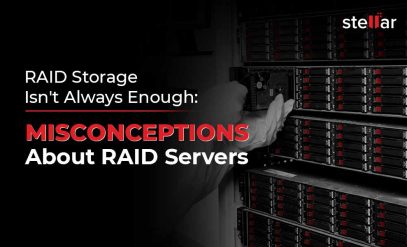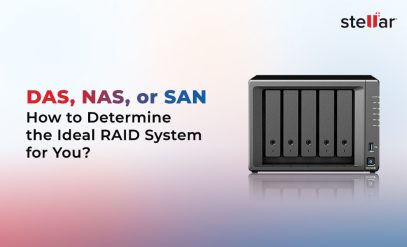| Summary: There can be many reasons for data loss from RAID Servers. In this blog, we have explained various reasons for data loss in RAID Servers. You will also find RAID data recovery methods and tips for preventing data loss from RAID Server. |
|---|
Table of Contents
- Reasons for Data Loss from RAID Server
- Methods to Recover Data from RAID Server
- Steps to Recover Data from RAID Server
- Tips to Prevent Data Loss from RAID Server
RAID is implemented by businesses to provide data redundancy and to enhance performance. But this redundancy is limited to a specific number of failed disks. For instance, RAID 0 provides no data redundancy, RAID 1 and RAID 5 give a tolerance of single disk failure, and so on. Hence, you can’t rely on this redundancy for long as the load increases on the working disks making them susceptible to crash, and leading to a complete data disaster. Learn more about different RAID levels and their advantages and disadvantages and recover data from RAID Servers.
Disk failure isn’t only the cause of data loss. There could be several other reasons for RAID failure and data loss. Data loss happens due to accidental deletion or formatting as well. As the loss of your business data directly hits the business revenue, you must consider contacting a Professional Data Recovery Service provider to recover data from the RAID server. Before we get to know the methods of recovery, let’s have a look at some of the common causes of data loss from the RAID server.
Reasons for Data Loss from RAID Server
Given below are some of the points which could act as a checklist to know the cause of RAID failure or data loss. This would enable you to take action accordingly.
- Member disk(s) physically damaged
- RAID rebuilding failed
- Multiple disks failed
- Disks are not detecting
- Power surge
- File System of member disks got corrupt
- RAID configuration issues
- RAID controller failed
- Bad sectors on disks
- Damaged boot record
- Virus infection
- RAID server issues—OS couldn’t be loaded, OS got corrupt, applications malfunctioned, corrupted drivers, etc.
- Natural disasters
Depending upon the cause, you may take action to recover the lost or inaccessible data. In the upcoming section, we’d talk about data recovery from RAID servers and the risks involved.
Additional Reading: RAID Storage: Common Misconceptions About RAID Servers
Methods to Recover Data from RAID Server
There could be one or more reasons for data loss from a RAID server. It’s really cumbersome to identify the exact cause, and the data recovery is even more complex. A minute mistake may catalyze the imminent RAID failure leading to permanent data loss. For instance, failure of the RAID rebuild might lead to multiple disks failure.
If you’ve lost data, you must first check if it’s the Server, RAID controller, RAID configuration, or any other component that’s related to your RAID setup has malfunctioned. Or, if the disks have been damaged.
If the data loss is caused due to damaged disks, you must check if this damage is physical, logical, or both. Physical damage is the physical crash of disks which might be preceded by weird noises out of the disks, overheating, or other symptoms. Whereas, logical damage is the corruption of software components stored on the disks. For instance, data loss due to virus infection or file system corruption is logical damage.
Steps to Recover Data from RAID Server
- To recover data from a damaged disk, you would need to open the disks to examine them in Class 100 Clean Room Lab which has a controlled level of airborne particles. Such an environment prevents any inadvertent damage to the platter while performing disk examination.
- If there is physical damage, you are required to replace the damaged components with suitable components. This is a complex task that needs technical expertise and an inventory of spare parts.
- Once the disks have become functional, you would need to clone them by using specialized software.
- After you’ve cloned the disks, the next action is to find out the logical parameters of the RAID array. These parameters include strip size, RAID level, data flow pattern, and parity flow information. These demand the use of specialized tools, techniques, and expertise.
- Once you know the RAID parameters, you can reconstruct them.
- Finally, you would need to run software that performs file signature-based scanning of the disks—also referred to as deep scan—for data recovery from RAID.
From the mentioned steps, it’s evident that data recovery from RAID server is an arduous job that necessitates advanced expertise, and specialized infrastructure and tools. You must be sure about the exact cause, and be very careful before trying to fix RAID errors or failure on your own, as the loss of your business data stored on the RAID disks might bring huge losses to your business.
To avoid permanent data loss or a complete RAID failure, contact a Professional Data Recovery Service provider who has expertise in RAID data recovery. For instance, Stellar® had recently recovered data from Barracuda® Message Archiver, which was set up in RAID configuration. The other recent success story is data recovery from RAID 5 configuration.
As RAID configurations are tough and generally store essential business data, you must be aware of the preventive measures against data loss or RAID failure.
Tips to Prevent Data Loss from RAID Server
You must always follow the best practices to prevent data loss. Here are a few tips that you may incorporate:
- Avoid RAID partition reconfiguration
- Keep the disks labeled
- Use Antivirus to avoid attacks of virus
- Make sure that the server has a power backup
- Avoid hit-and-trial methods in case of RAID failure or errors
- Backup the data regularly
- Contact a Professional Data Recovery Service Provider as soon as you observe RAID failure symptoms
Additional Reading: How to recover data from Raid 5?
Conclusion
Data redundancy provided by RAID configuration is conditional, and RAID setups aren’t immune to data loss. You must know the root cause before running any utility to repair the RAID or to recover data on your own. RAIDs are complex to handle and hence should be taken care of by a Professional Data Recovery Service Provider in case of a failure or data loss.








